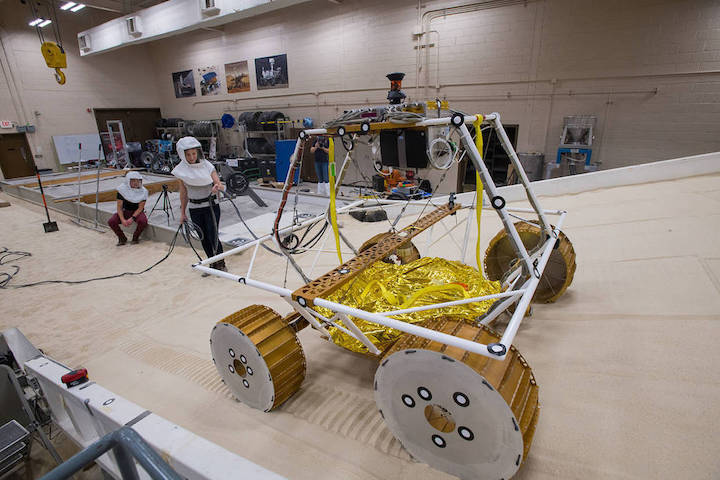26.01.2020

Photo: NASA/Bridget Caswell, Alcyon Technical Services
NASA has decided that humans are going back to the Moon. That’s great! Before that actually happens, a whole bunch of other things have to happen, and excitingly, many of those things involve robots. As a sort of first-ish step, NASA is developing a new lunar rover called VIPER (Volatiles Investigating Polar Exploration Rover). VIPER’s job is to noodle around the permanently shaded craters at the Moon’s south pole looking for water ice, which can (eventually) be harvested and turned into breathable air and rocket fuel.
An engineering model of the Volatiles Investigating Polar Exploration Rover, or VIPER, is tested in the Simulated Lunar Operations Laboratory at NASA’s Glenn Research Center in Cleveland, Ohio. About the size of a golf cart, VIPER is a mobile robot that will roam around the Moon’s South Pole looking for water ice in the region and for the first time ever, actually sample the water ice at the same pole where the first woman and next man will land in 2024 under the Artemis program.
In the video, the VIPER engineering model is enjoying playtime in simulated lunar regolith (not stuff that you want to be breathing, hence the fancy hats) to help characterize the traction of the wheels on different slopes, and to help figure out how much power will be necessary. The final rover might look a bit more like this:
VIPER is more than somewhat similar to an earlier rover that NASA was working on called Resource Prospector, which was cancelled back in 2018. Resource Prospector was also scheduled to go to the Moon’s south pole to look for water ice, and VIPER will be carrying some of the instruments originally developed for Resource Prospector. If it seems a little weird that NASA cancelled Resource Prospector only to almost immediately start work on VIPER, well, yeah—the primary difference between the two rovers seems to be that VIPER is intended to spend several months operating, while Resource Prospector’s lifespan was only a couple of weeks.
The other big difference between VIPER and Resource Prospector is that NASA has been gradually shifting away from developing all of its own hardware in-house, and VIPER is no exception. One of the primary science instruments, a drilling system called TRIDENT (The Regolith and Ice Drill for Exploring New Terrain, obviously), comes from Honeybee Robotics, which has contributed a variety of tools that have been used to poke and prod at the surface of Mars on the Mars Exploration rovers, Phoenix, and Curiosity. There’s nothing wrong with this, except that for VIPER, it looks like NASA wants a commercial delivery system as well.
Last week, Space Newsreported that NASA is postponing procurement of a commercially-developed lander that would deliver VIPER to the lunar surface, meaning that not only does VIPER not have a ride to the Moon right now, but that it’s not very clear when it’ll actually happen—as recently as last November, the plan was to have a lander selected by early February, for a landing in late 2022. From the sound of things, the problem is that VIPER is a relatively chunky payload (weighing about 350 kg), meaning that only a few companies have the kind of hardware that would be required to get it safely to the lunar surface, and NASA has a limited budget that also has to cover a bunch of other stuff at the same time.
This delay is unfortunate, because VIPER plays an important part in NASA’s overall lunar strategy. Finding water ice on the Moon is the first step towards the in-situ resource utilization (ISRU) robots necessary to practically sustain a long-term lunar mission, and after that, it’ll take a bunch more work to actually deploy a system to harvest ice and turn it into usable hydrogen and oxygen with enough reliability and volume to make a difference. We have the technology—we’ve just got to get it there, and get it working.
Quelle: IEEE
